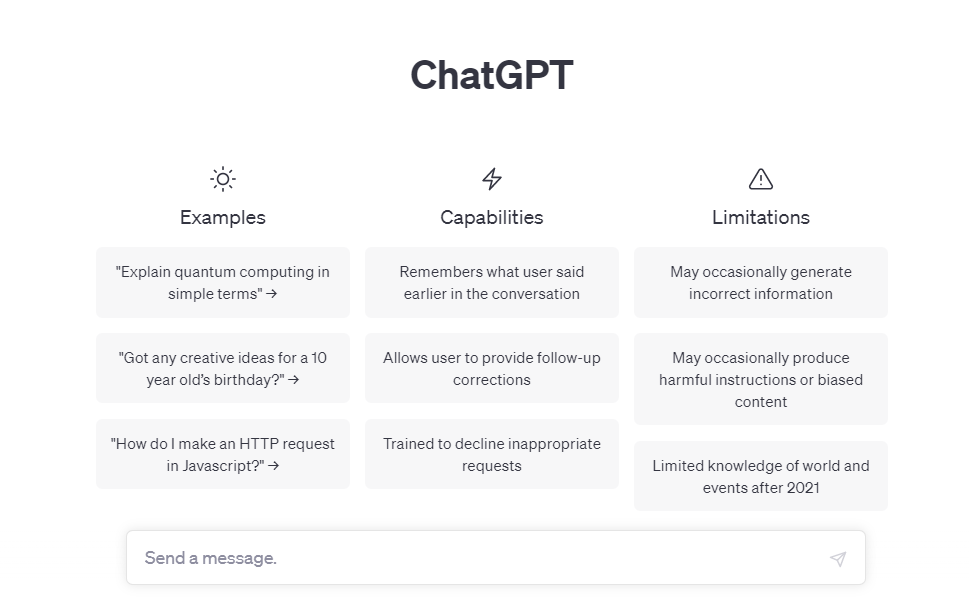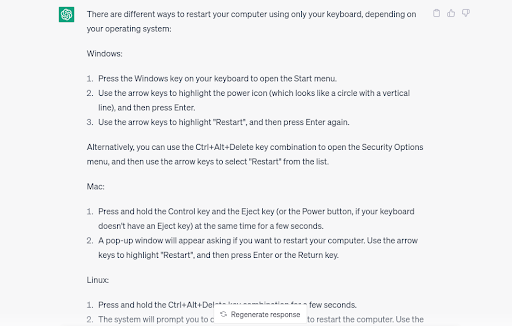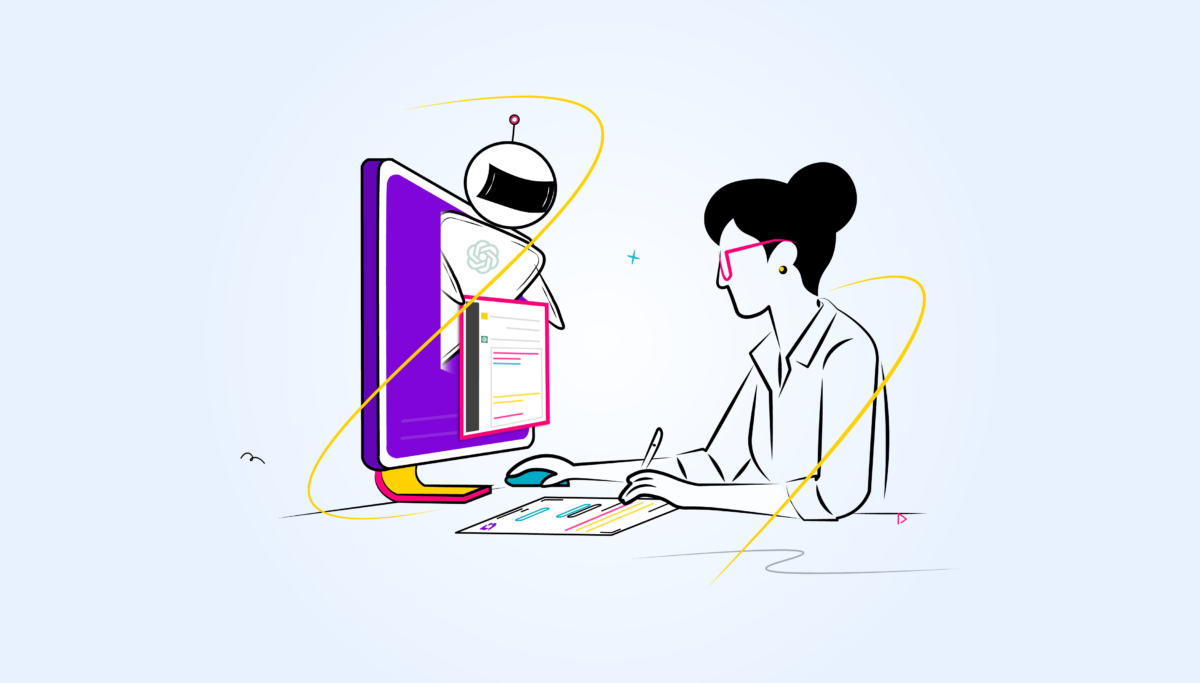Any technical writer worth their salt is going to spend at least some of their time looking for new technologies that can assist in their technical writing. One new technology causing a stir is ChatGPT by OpenAI, which not only offers unique possibilities for technical writers but is also currently free to use. Anyone can sign up for ChatGPT and start experimenting with AI.
The potential for AI technologies to impact fields such as technical writing is huge, but it should be remembered that machines are still a long way from replacing their human counterparts. At the moment, you can use ChatGPT to overcome some typical hurdles when it comes to writing technical documentation.
Technical writers are already using many technical writing tools to assist in the creation of their documentation, so it’s one short step to adopting AI tools such as ChatGPT to help overcome technical writing challenges. It has the potential to save you time and effort by searching and analyzing the data that has been fed to it in order to generate its intelligence.
What is ChatGPT?
ChatGPT is a language model that has been launched by the Artificial Intelligence organization OpenAPI, which develops AI technology for the benefit of humanity and adopts a human-centered approach.
GPT stands for Generative Pre-trained Transformer, and the tool is a chatbot that has the ability to interact in a conversational style. When you talk to ChatGPT, it will respond much as a human would and can be used to generate text documents such as those that would be useful in technical writing.

As a chatbot, ChatGPT is essentially a writing tool that can help writers to generate high-quality content that has been informed by a huge range of sources from the internet. Not only does ChatGPT understand questions, but it can form responses that have a creative element that simulates human intelligence.
Amazingly, ChatGPT also has the ability to debug code if you enter a question and code snippet that is not working correctly. ChatGPT will interact with you in a conversational mode to find the reason for the error and provide suggestions for fixing it.
How to use it
One way that you could use ChatGPT to help with your technical writing is by asking it a question, and ChatGPT will generate an answer that you can use as the basis of a technical article. ChatGPT will scan massive amounts of data (up to the year 2021) , which you can adapt to your own particular specifications. If you have writer’s block, ChatGPT is an excellent way to overcome this hurdle and provide you with a starting point.
Another way to use ChatGPT is to optimize your content for SEO. You can ask ChatGPT to search for keywords related to a particular topic and use them as a structure for your article, which will help to get more visibility for content on search engines. ChatGPT’s applications for SEO are important because technical writers want users to find their documentation when searching online.
It’s not strictly related to technical writing, but you can also use ChatGPT to write poems or short stories. ChatGPT has the capability to be creative and even have a philosophical discussion with you, so that’s why it’s generating so much interest among its user base. The ability to use ChatGPT for different purposes is limited only by your imagination, but at the end of the day, it is still only Artificial Intelligence.
Limitations
So at the moment, ChatGPT cannot be used for writing technical manuals, so technical writers can rest assured that they are still essential in their jobs. The limitation of ChatGPT is that it can only regurgitate information that it has already read in the past and that the skill of creating truly original content still belongs to humans. Highly specific technical documentation is still the preserve of technical writers who have domain knowledge.
Similarly, ChatGPT is still prone to responding with some inaccuracies regarding questions that are asked of it, and OpenAPI is working on a way to overcome this hurdle. While ChatGPT can currently simulate human intelligence, it remains limited by the fact that it is a machine.
How to use ChatGPT for Technical Writing?
To use ChatGPT in technical writing, you must first use your Google account to sign up. ChatGPT has a free plan, but you can also sign up for a paid subscription called ChatGPT Plus. ChatGPT Plus offers a number of benefits, including access during peak times, faster responses, and priority access to new features and improvements.
Once you have access to ChatGPT, start by asking it a question. Phrase it in such a way as you would naturally speak to a fellow human being, and ChatGPT will understand what you mean. ChatGPT will then generate an answer based on the sources it has available to it.
Come up with ideas for using ChatGPT in your technical writing, such as creating potential structures for your articles. If you have existing content, feed it to ChatGPT to see how it could be improved. ChatGPT can help you structure your content and help provide alternative phrasing, as well as optimize your document for SEO.
Here’s an example of an answer to a question in ChatGPT:

As you can see, ChatGPT has the ability to analyze the validity of an input and provide a coherent response based on the knowledge from its database. In technical writing, you could use ChatGPT to answer a similar question, such as “How can I reboot my computer?” Of course, ChatGPT is unlikely to have knowledge of specific systems but will be able to provide you with a general answer based on other data from the internet, which you can then fact-check for your specifications.
An intuitive technical documentation software to easily add your content and integrate it with any application. Give Document360 a try!
GET STARTED
Benefits of ChatGPT for Technical Writing
Improve Efficiency
While human writers may take a long time to research and write documentation, ChatGPT can generate content in seconds. It has the ability to scan vast amounts of data in a way that no human ever could, and therefore take advantage of the collective intelligence. Technical writers could use ChatGPT to help them complete a project in a much shorter time span than usual.
Consistency in Grammar and Sentence Formation
ChatGPT has been trained on a wide variety of textual data which means that it can be used to create content that has human-like grammar and formatting. ChatGPT documentation makes sense because it has access to millions of examples that have informed its answer to any question that has been asked of it.
To Rewrite, Restructure and Make Information More Concise
ChatGPT can be used on existing text to rewrite the content and ensure that it is more concise for the reader. If you already have documentation in progress, you can use ChatGPT to make it better. It has the capability to make your content more readable by distilling it down to the essential points.
Help Produce Content at Scale
Due to ChatGPT’s vast writing capabilities, larger technical writing projects can benefit from its input as this tool will be able to generate a high volume of output. It takes ChatGPT the same time to produce one document as it does to create tens of documents, meaning that you can achieve your technical writing goals in a much more reasonable timeframe.
Impact of Using ChatGPT for Technical Documentation
ChatGPT has the ability to impact technical documentation by researching huge amounts of information and using it to contribute to the formation of content. Writers can use ChatGPT in a conversational manner to improve their work and structure articles in a way that might otherwise take days to achieve.
Technical writers can gain an idea of what has already been written on a topic to inform their own writing and make it more comprehensive. If you have a question on a subject, ChatGPT can answer it, which can add depth to your writing that might not otherwise be possible.
With the knowledge available to ChatGPT, you can use it to take your technical writing to the next level. While ChatGPT remains simply a tool, it is up to technical writers to find applications for this technology that can benefit them in new and profound ways.
Limitations of ChatGPT in Technical Writing
Technical Principles are not Well Understood
While technical writers usually have a deep understanding of their domain, ChatGPT doesn’t have a particularly good grasp of technical principles. That means you will be unable to generate documentation that will be genuinely helpful to users in a technical sense, as ChatGPT will only be able to produce generic text on any given topic. While ChatGPT can analyze the grammar and structure of your work, it will not be able to fact-check the documentation.
Inadequate Context and Coherence
While ChatGPT can regurgitate content on a specific subject, it does not have the ability to apply context to what has been written. This means there might be background information that is left out and results in text that is lacking in meaning. Coherence is a problem for ChatGPT since it cannot truly understand what will make sense to the reader.
Style Inconsistency in Writing
If you ask ChatGPT different questions,it will likely return answers with different styles, which is not the best output for your readers. Technical writers have the ability to ensure a consistent style across their documentation which cannot currently be mirrored by ChatGPT. Content that feels like it has been written by different authors is prohibitive to the success of end users.
Inability to Adhere to Particular Guidelines
Technical writing usually has to adhere to strict guidelines which are specific to a particular organization or industry. ChatGPT can’t understand guidelines or the need to produce documentation to a certain standard, which means any content created by ChatGPT will need to be rigorously edited.
Lacks Consideration of the Law and Ethics
As ChatGPT is artificial intelligence, it doesn’t understand any consideration of the law or ethics, which means that textual output might not be original or might encourage questionable actions. Technical writers must always use their insight when employing technologies such as ChatGPT to ensure they don’t break any rules.
Maximizing your technical documentation using ChatGPT
Use ChatGPT for what it currently does best – creating a starting point with inspiration that you can then build on to achieve truly useful technical documentation. ChatGPT can research technical topics at a speed that far outstrips the capabilities of human technical writers, and come up with text that you can then use for original content.
When you want to generate new ideas for topics that will interest your readers, use ChatGPT as an idea generator. It has access to an unfathomable amount of data from the internet which can provide inspiration in your work as a technical writer.
Also Read: The Future of Knowledge Base in the Age of Generative AI
Conclusion
Use ChatGPT to play around with the possibilities for your technical writing. Use it as inspiration and as a way to research large amounts of information at once, then go on to create original content for your users. The more people who use ChatGPT, the more intelligent it will get and develop the ability to enhance the field of technical writing.
While there is no risk of ChatGPT replacing technical writers, it is a tool that makes some of the mundane tasks associated with technical writing significantly easier, which frees up technical writers to use their skills in more productive and useful ways.
ChatGPT is an exciting new tool that can add to the already extensive arsenal of technologies that technical writers currently use to help their users. Artificial Intelligence is developing to a point where it can be used to significantly enhance the current abilities of its human users.
Schedule a demo with one of our experts to take a deeper dive into Document360
Book A Demo







